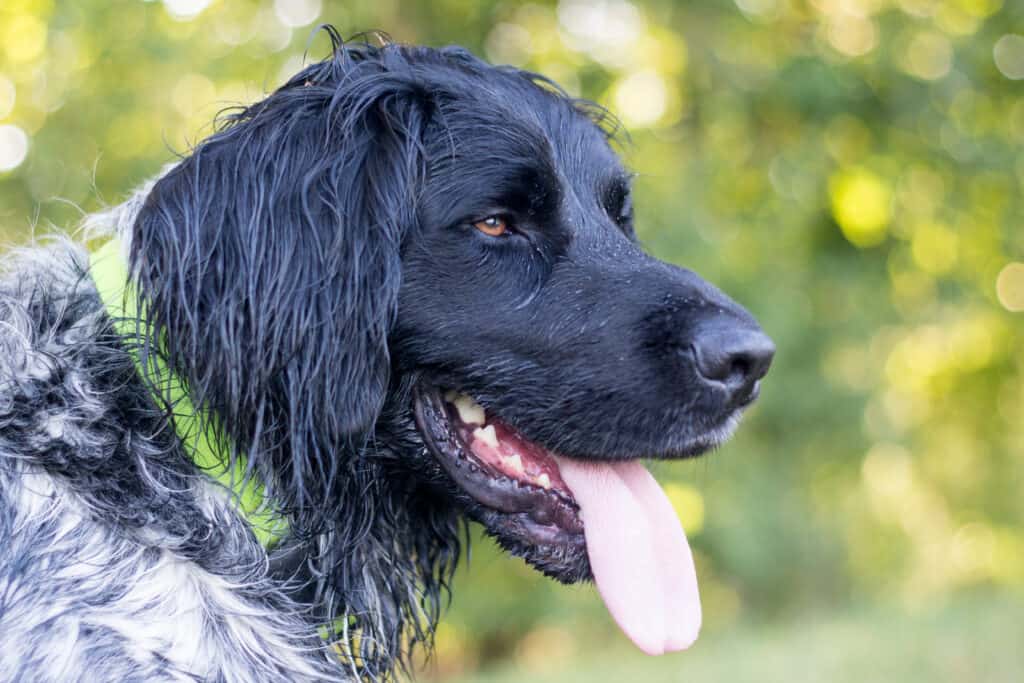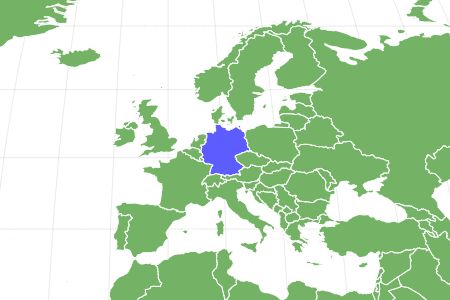Large Munsterlander
Canis lupus
Some people might find the Large Munsterlander too lively for their family, but they are actually very gentle with children and make fantastic family pets.
Advertisement
Large Munsterlander Facts
- Prey
- Birds, Rabbits and small mammals
- Name Of Young
- Puppy
- Group Behavior
- Social
- Fun Fact
- Some people might find the Large Munsterlander too lively for their family, but they are actually very gentle with children and make fantastic family pets.
- Most Distinctive Feature
- White and black coloring
- Gestation Period
- 63 days
- Temperament
- Gentle
- Training
- Easy
- Litter Size
- 5 to 10 pups
- Diet
- Omnivore
- Lifestyle
- Diurnal
- Common Name
- Large Munsterlander
- Origin
- Germany
Large Munsterlander Physical Characteristics
- Color
- Black
- White
- Skin Type
- Fur
- Height
- 22 to 28 inches
- Age of Sexual Maturity
- 6 to 9 months
- Age of Weaning
- 3 to 6 weeks
- Aggression
- Low
Large Munsterlander as a Pet:
- General Health
- Energy Level
- Shedability
- Trainability
- Intelligence
- Tendency to Chew
- Size
- Family and kid friendliness
- Yappiness / Barking
- High
- Separation Anxiety
- Moderate
- Preferred Temperature
- Cold climate
- Exercise Needs
- High
- Friendly With Other Dogs
- High
- Pure bred cost to own
- $1400 to $1800
- Dog group
- Working
- Male weight
- 59-73 lbs
- Female weight
- 50-60 lbs
View all of the Large Munsterlander images!
The Large Munsterlander is one of the best hunting dogs and loyal companions that originate from Germany. They excel at hunting because of their impressive level of endurance and strong natural instincts, helping them face adverse weather conditions and rough terrain.
Dog owners should think twice before purchasing this breed because they need tons of mental and physical stimulation to stay healthy and happy. Small backyards and hour-long walks will not be enough for the Large Munsterlander. They need large open spaces and interactive play; in fact, most breeders will only sell pups to hunting homes and won’t even consider any other environment.
However, if you qualify to own one of these beauties, they will be an asset to your home. They are gentle, happy, great with children, and highly trainable.
Two Different Types of Munsterlanders
There are only two types of Munsterlanders:
- Large Munsterlander
- Small Munsterlander
While the Large Munsterlander is slightly taller than the Small Munsterlander, the real difference between the two is their legs. The Large Munsters have shorter bodies and longer legs compared to the Small Munsters, which have longer bodies and shorter legs.
This makes Large Munsterlanders more desirable for hunting because their long legs cover the same amount of ground without using as much energy.
There are no hybrids of this breed because the hunting community, who is mainly responsible for breeding Munsterlanders, does not participate in cross-breeding.
Three Pros and Cons of Owning a Large Munsterlander
While this breed has a lot of pros, there are some cons that dog owners should be aware of before purchasing one:
Pros
- Obedient
- This breed is the perfect companion for families with older children and other dogs
- A very intelligent breed
Cons
- Extremely dominant
- Barks frequently if left alone
- Won’t do well in homes with small non-canine pets
The Best Dog Food for a Large Munsterlander
The Large Munsterlander needs a top-quality dry or wet diet to sustain its active lifestyle. Dog food specially formulated for large dogs will work well for this breed.
However, dog foods for active or working breeds might be a better choice due to their energy level and active nature.
Large Munsterlander Size and Weight
Large Munterlander males are bigger than females, weighing 59 to 76 pounds and growing to heights of 24 to 28 inches. Females weigh 50 to 60 pounds and measure 22 to 26 inches tall.
But what distinguishes them most from other breeds, like the German Shorthaired Pointer, is their black and white coat with thick, medium-length hair
Large Munsterlander Common Health Issues
The Large Munsterlander is a healthy dog; breeders have carefully managed this breed and ensured their genetics are strong. However, because they are active outdoor pets, owners should frequently check their ears and coats for ticks and burrs.
In addition, they may also suffer from the following:
For a large breed, they have a relatively long lifespan of 12 to 13 years, but they often live as long as 15 years old.
Large Munsterlander Temperament
The Large Munsterlander is a formidable and intelligent dog with incredibly high energy levels, which makes it an unsuitable pet for owners with small properties. They can become frustrated and destructive if they do not reach their full potential. However, they are happy and calm dogs if exercised often or taken hunting regularly.
While they are independent, the Large Munsterlander is responsive and sensitive to its family. They are great with children but may be too boisterous for families with younger kids. In addition, they do well with other dogs but might try to hunt smaller pets like cats, birds, or rabbits.
How to Take Care of a Large Munsterlander

The Large Munsterlander is a formidable and intelligent dog with incredibly high energy levels, which makes it an unsuitable pet for owners with small properties.
©LokoPhoto/Shutterstock.com
For a working dog, this breed has a complex maintenance routine. Owners must commit to rigorous grooming, training, and exercise for 13+ years.
Grooming
This breed has a long, wavy coat that needs grooming 2 to 3 times a week to keep it healthy and knot-free. In addition, their fur attracts seeds, grass, and other plant matter that needs removing.
Large Munsterlanders do not need to bathe often. Washing them too much affects their natural waterproofing, which is required to survive in cold, wet environments. These dogs may suffer from ear infections, so they need a proprietary ear wash every two weeks.
Their claws need trimming as soon as they start touching the ground, usually every 2 to 3 months. In addition, dental health is very important in canines, so they need their teeth brushed at least 3 times a week with high-quality dog toothpaste.
Training
The Large Munsterlander is known for its intelligence and is ranked one of the best hunting breeds in the world. But this breed is also obedient and has a gentle nature, making it easy to train to a high standard. They thrive from positive reinforcement and gentle training.
Exercise
Large Munsterlanders require a lot of exercise, like most hunting dogs. They need a high-powered 60 walk or jog every day, along with work or play where they can run.
Taking these dogs to a place where they can run around free is necessary. Their natural instincts will immediately kick in, and they will start to hunt for critters under each bush.
This breed is not suitable for seniors or inactive people; they are perfect for families or young couples that like the outdoors.
Puppies
Large Munsterlander females give birth to around 5 to 10 puppies after a gestation period of approximately 63 days. The pups are very energetic and destructive, so breeders and owners need a lot of patience.
The price of these puppies can vary depending on the location, reputation of the breeder, and pedigree. They can cost anywhere from $1,400 to $1,800.
Large Munsterlander and Children
Some people might find the Large Munsterlander too lively for their family, but they are actually very gentle with children and make fantastic family pets. In fact, they usually burn out all their energy outdoors and are calm and collected when inside the home.
Because of their high trainability, owners can easily train them to behave in a specific way around their children. In addition, their high energy makes them compatible companions for kids; they can keep each other busy all day.
Dogs similar to the Large Munsterlander
While the Large Munsterlander is a unique dog, there are several breeds similar in size and behavior:
Belgian Sheepdog
The Belgian Sheepdog is notorious for its intelligence and loyalty. This breed is highly trainable, and in the 1800’s they were used for all types of interesting tasks, like:
- Herding
- Police chases
- Delivering messages
Today they are known for their canine performance and showmanship, and they make great companions. They are the perfect breed for first-time owners with children. In addition, they will adapt well to multi-pet homes. However, their long fur means they need a lot of grooming and shed a lot.
Belgian Sheepdogs are active and need at least an hour of daily physical activity. They also need mental stimulation, like an interactive game daily, to stay happy and healthy. If they are under-stimulated, they can become destructive.
Flat-coated Retriever
The Flat-coated Retriever is a fascinating dog that comes in two colors, black, and liver. They are large dogs, up to 24.5 inches tall and weighing around 80 pounds.
Retrievers were initially bred in England as water dogs and later used as hunting companions in the 1800s. But, they were soon overshadowed by their cousins, the Golden Retriever.
This breed is goofy, sweet, and hardworking; they will get along great with children and other pets and keep the family entertained with their crazy antics.
Vizsla
The Vizsla is a very unique breed that originated in Hungary. They were bred to assist with falconry, which involves training birds of prey for hunting purposes. The Vizsla hunted with the birds to help capture small mammals, rabbits, and birds.
There are even records dating back to the Middle ages that document the Vizsla being used in falconry. These dogs are medium-sized, muscular, and rust-colored, with a shiny single coat, making grooming a breeze. They are very active dogs and need at least 45 to 60 minutes of vigorous daily exercise.
Popular Names for a Large Munsterlander
Because of their German ancestry, the most popular names for the Large Munsterlander are very unique and beautiful:
- Fritz
- Blitz
- Ziggy
- Arnold
- Dieter
- Lottie
- Ella
- Mischa
- Sascha
- Addie
Up Next
View all 98 animals that start with LLarge Munsterlander FAQs (Frequently Asked Questions)
How much is a Large Munsterlander?
The price of these puppies can vary depending on the location, reputation of the breeder, and pedigree. They can cost anywhere from $1,400 to $1,800.
What is the difference between a large and Small Munsterlander?
While the Large Munsterlander is slightly taller than the Small Munsterlander, the real difference between the two is their legs. The Large Munsters have shorter bodies and longer legs compared to the Small Munsters, which have longer bodies and shorter legs.
How much exercise does a Large Munsterlander need?
Large Munsterlanders require a lot of exercise, like most hunting dogs. They need a high-powered 60 walk or jog every day, along with work or play where they can run.
Thank you for reading! Have some feedback for us? Contact the AZ Animals editorial team.
Sources
- Vet Street, Available here: https://www.vetstreet.com/dogs/large-munsterlander/
- Dog Breed Info, Available here: https://www.dogbreedinfo.com/largemunsterlander.htm
- Dog Zone, Available here: https://www.dogzone.com/breeds/large-munsterlander/
- Dog-Learn, Available here: https://www.dog-learn.com/dog-breeds/large-munsterlander/
















